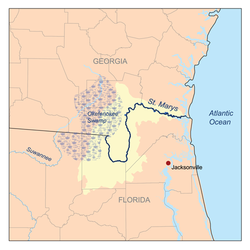Battle of Fort Peter: Difference between revisions
Az81964444 (talk | contribs) |
Az81964444 (talk | contribs) |
||
| Line 29: | Line 29: | ||
They then headed for St. Marys, along St. Marys River, when ambushed by a smaller American force. The shore party fought off the attacks on January 13 and 14, on January 15 captured the small town after the battle ended, looting the [[jewelry store]] and stealing fine china from the residents. The British ended their occupation after recieving word of the February 17, 1815 ratifying of the [[Treaty of Ghent]]. This small battle is significant for being the only land engagement during the war to occur in Georgian territory. Casualties are unknown. |
They then headed for St. Marys, along St. Marys River, when ambushed by a smaller American force. The shore party fought off the attacks on January 13 and 14, on January 15 captured the small town after the battle ended, looting the [[jewelry store]] and stealing fine china from the residents. The British ended their occupation after recieving word of the February 17, 1815 ratifying of the [[Treaty of Ghent]]. This small battle is significant for being the only land engagement during the war to occur in Georgian territory. Casualties are unknown. |
||
==Fort Peter Today== |
|||
Fort Peter was burnt to the ground by the British after their victory and never rebuilt. In 1953, a historical marker was placed at the battle. As of 2009, archeologists have found thousands of artifacts, including weapons, muskets, musket balls, knives, buttons among other things. |
|||
==See also== |
==See also== |
||
Revision as of 04:19, 25 October 2009
| Battle of Fort Peter | |||||||
|---|---|---|---|---|---|---|---|
| Part of War of 1812 | |||||||
 St. Marys River | |||||||
| |||||||
| Belligerents | |||||||
|
|
| ||||||
| Commanders and leaders | |||||||
| George Cockburn | unknown | ||||||
| Strength | |||||||
| ~600 marines | ~130 militia | ||||||
The Battle of Fort Peter or the Battle of Point Peter was a naval attack of St. Marys, Georgia and the town's citadel, the small Fort Peter. Between a British force of Royal Marines and a smaller troop of American militia during the War of 1812. The engagement occurred at the same time as the Siege of Fort St. Philip in Louisiana.
Battle
On January 10, 1815, British forces under the command of Admiral Sir George Cockburn landed on Cumberland Island in an effort to tie up American forces and keep them from joining other American forces to help defend New Orleans, Louisiana, and the Gulf Coast.
Bad weather and lack of materials and ships delayed Cockburn until it was too late to produce any effect on the outcome of the battle for New Orleans. Despite the U.S. victory at New Orleans, the occupation of Cumberland Island continued. On January 13 a British force first bombarded and then attacked by land the Georgia mainland, landing near the American Fort Peter on Point Peter by the town of St. Marys. A two day battle occurred at the Fort Peter and around it, specifiacally St. Marys River. The British captured the fort after defeating it's garrison of 130 militiamen.
They then headed for St. Marys, along St. Marys River, when ambushed by a smaller American force. The shore party fought off the attacks on January 13 and 14, on January 15 captured the small town after the battle ended, looting the jewelry store and stealing fine china from the residents. The British ended their occupation after recieving word of the February 17, 1815 ratifying of the Treaty of Ghent. This small battle is significant for being the only land engagement during the war to occur in Georgian territory. Casualties are unknown.
Fort Peter Today
Fort Peter was burnt to the ground by the British after their victory and never rebuilt. In 1953, a historical marker was placed at the battle. As of 2009, archeologists have found thousands of artifacts, including weapons, muskets, musket balls, knives, buttons among other things.
See also
- St. Marys Historic District
- British occupation of St. Marys and Cumberland Island
- American South theatre of the War of 1812
